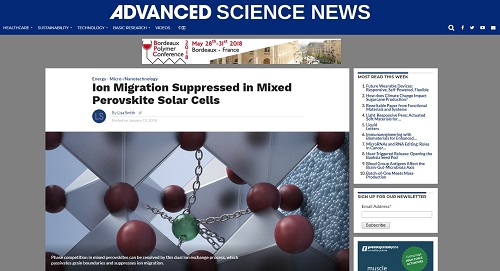Paper of Prof. XU, Jianbin's team has been highlighted on the Advanced Science News
Paper of Prof. XU, Jianbin's team in Advanced Energy Materials "Crystallinity Preservation and Ion Migration Suppression through Dual Ion Exchange Strategy for Stable Mixed Perovskite Solar Cells" is highlighted by Advanced Science News, a news outlet to distribute high impact outputs in Advanced Energy Materials (with Impact Factor 10). This research is an inter-institutional collaboration between The Chinese University of Hong Kong and Jinan University, China.
Perovskite solar cell (PSC) is one of the leading frontier research topics worldwide. In 2013, PSC was selected by the Science journal as one of the "Top 10 Breakthroughs of 2013". The raw material of this kind of solar cells is a particular kind of instable perovskite, which hampered its efficiency.
Researchers have been studying mixed perovskites, which have enhanced efficiency than the homogeneous material itself. They found that the introduction of formamidinium ions to mixed perovskites improved its light-harvesting efficiency. However, the less desirable side effect for a material containing two different phases is the competition that occurs between them. When the two crystal types are mixed directly, they crystallize separately, thereby introducing defects and leading to instability in its performance.
The team developed a dual ion exchange (DIE) method, which resolved the problems by allowing the healing of any structural defects forming at the grain boundaries. It also lends a certain moisture stability to the mixed perovskite structure, which reduced impurity scattering and fostered to the power conversion efficiency (PCE). A moisture stability of over one month in a relative humidity of 65% was observed, with an average PCE of 17%. In fact, using this dual ion exchange process, these researchers achieved a maximum PCE of 18.1% with negligible hysteresis.
For details, please click here




